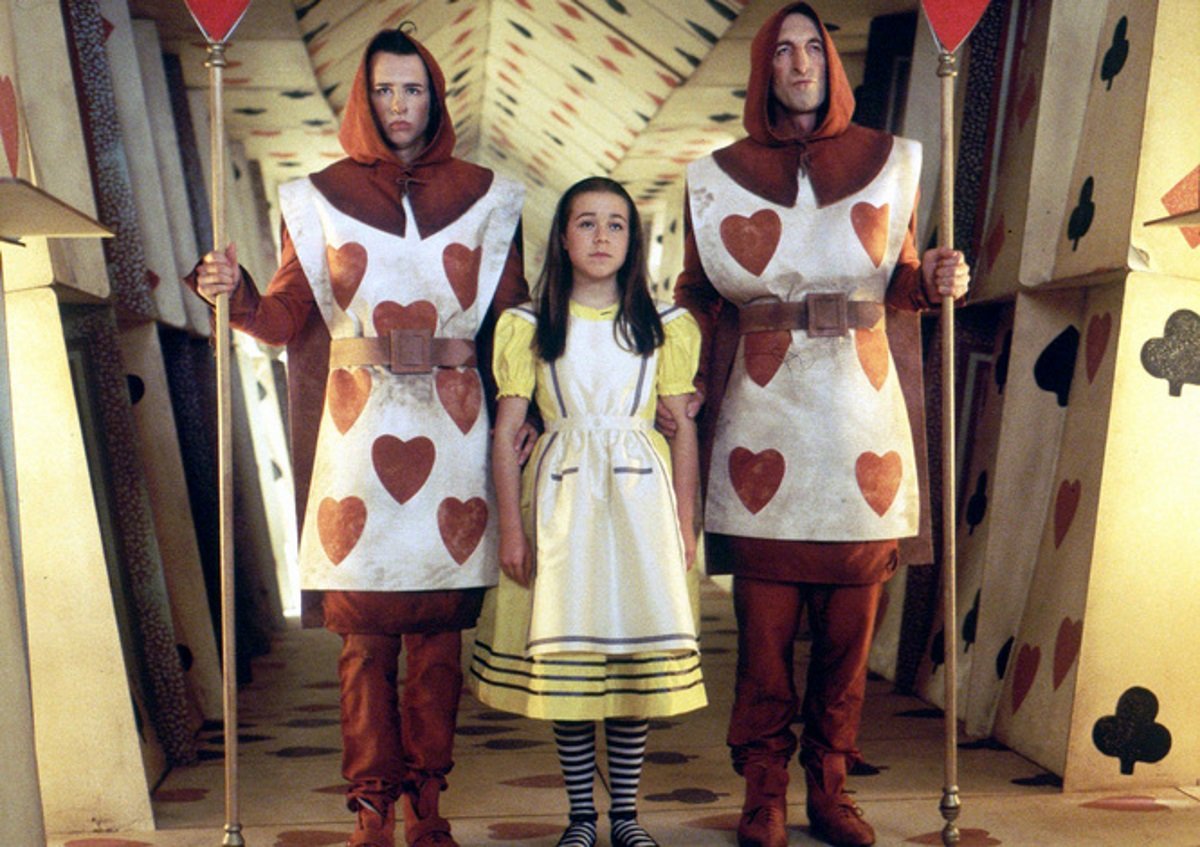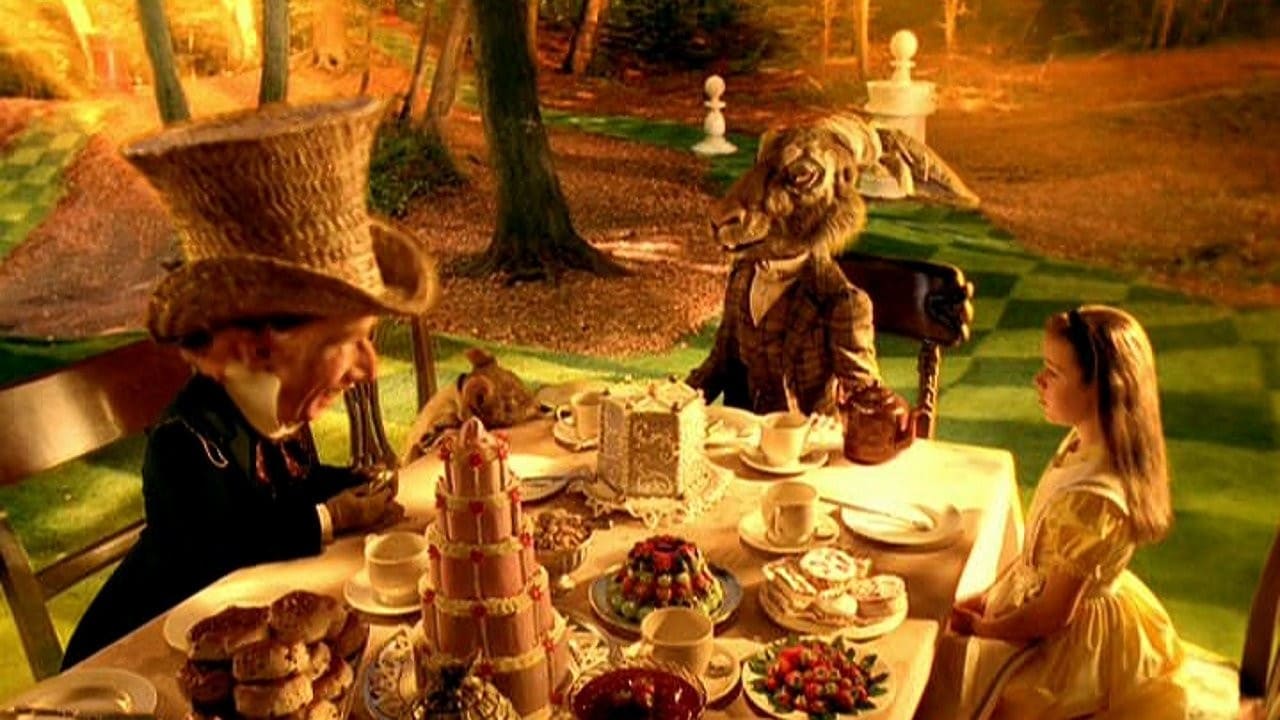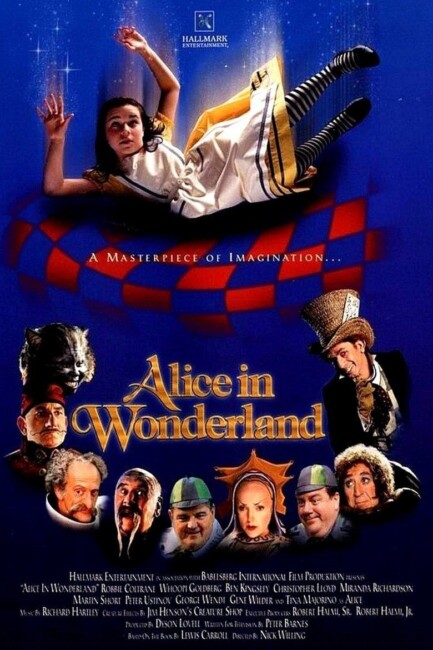Crew
Director – Nick Willing, Teleplay – Peter Barnes, Based on the Novels Alice’s Adventures in Wonderland and Through the Looking Glass by Lewis Carroll, Producer – Dyson Lovell, Photography – Giles Nutgens, Music – Richard Hartley, Visual Effects Supervisor – David Booth, Digital Video Effects – Framestore (London), Special Effects Supervisors – Richard Conway & Bob Hollow, Creature Effects – Jim Henson’s Creature Shop, Production Design – Roger Hall. Production Company – Hallmark Entertainment/Babelsberg International Filmproduktion & Co Betriebs KG.
Cast
Tina Majorino (Alice), Miranda Richardson (The Queen of Hearts), Martin Short (The Mad Hatter), Christopher Lloyd (White Knight), Whoopi Goldberg (Cheshire Cat), Robbie Coltrane (Ned Tweedledum), George Wendt (Fred Tweedledee), Francis Wright, Adrian Getley & Robert Tygner (The March Hare), Gene Wilder (The Mock Turtle), Simon Russell Beale (Cedric, The King of Hearts), Richard Coombs & Kiram Shah (The White Rabbit), Elizabeth Spriggs (The Duchess), Ben Kingsley (Major Caterpillar), Dave Barclay & Nigel Plaskitt (The Dormouse), Ken Dodd (Mr Mouse), Donald Sinden (Voice of The Gryphon), Dave Barclay, Adrian Getley & Robert Tygner (The Gyrphon), Peter Ustinov (Walrus), Pete Postlethwaite (Carpenter), Jason Flemyng (Sir Jack, The Knave of Hearts), Jason Byrne (Pat the Gardener), Paddy Joyce (Bill the Gardener), Janine Eser (Mother), Sheila Hancock (The Cook), Joanna Lumley (Voice of Tiger Lily)
Plot
Young Alice has a case of stage fright over having to sing a song at her parents’ tea party. Instead, she runs away into the garden. Hiding there, she is surprised by a White Rabbit and follows it, only to fall down into its hole. She finds herself in a bewildering world where she is unable to keep her size and is surrounded by strange creatures that talk nonsense.
This is a production of Lewis Carroll’s Alice’s Adventures in Wonderland (1865) that was made as a four-hour tv mini-series from Hallmark Entertainment, a production company that made numerous mini-series and tv movies for the Hallmark tv channel. (Hallmark Entertainment’s other genre productions are listed at the bottom of the page). Alice in Wonderland was made by British director Nick Willing. Nick Willing premiered with the excellent Photographing Fairies (1997) and then went onto make various other mini-series including Hallmark’s Jason and the Argonauts (2000), as well as his sf rationalised versions of The Wizard of Oz with Tin Man (2007) and Peter Pan with Neverland (2011), and other films like Doctor Sleep/Hypnosis (2002), The River King (2005) and Altar (2014), all of which fall within genre guidelines, as well as to create/produce the mini-series The Infinite Worlds of H.G. Wells (2001). Willing also later directed the tv mini-series Alice (2009), which does the same things as Tin Man, in updating Alice in Wonderland into a quasi science-fictional world.
Alice in Wonderland has been adapted and reinterpreted for the big and small screen so many times – some 60+ adaptations (see below) – that one wonders what yet another version of the story has to offer that is new or unsaid. Nick Willing certainly makes a solid attempt to bring the various Wonderland characters to life using animatronics and CGI (something that, to one’s knowledge, had not been employed on Lewis Carroll’s creations prior to this unless you count Dreamchild (1985), the Alice Liddell biopic). Willing also endeavours to give the story a certain dramatic push, although there is the feeling at the end that the mini-series is ultimately only a series of picaresque episodes as Alice encounters various Wonderland characters. The mini-series freely mixes aspects of both Alice’s Adventures in Wonderland and Lewis Carroll’s sequel Through the Looking Glass (1871) from which it imports a number of characters such as Tweedledum and Tweedledee, The White Knight and the encounter with the Garden of Live Flowers.

The best aspect of the mini-series is the wonderfully imaginative production design, including the White Rabbit’s house that folds up into a giant pop-up book, the woods that come in golden-lit hues with checkerboard patterned grass trails, and the courtroom that is designed like a giant deck of cards. All the creatures – the Dormouse, the Cheshire Cat, the March Hare, the flamingos and hedgehogs, the Gryphon, the White Rabbit – are given wonderful life by the Jim Henson Creature Workshop. Particularly surreal is the Lobster Quadrille dance, which offers up the bizarre sight of dancing porpoises, snails and lobsters.
As usual with most live-action productions of Alice of Wonderland, the mini-series serves as an opportunity for a huge line-up of well-known actors to regard the production as a variety show where they put on funny costumes and engage in pantomime performances. The best of these is the Mad Hatter’s Tea Party, which is played with a much more disturbed and demented undertow than it usually is in other adaptations, with Martin Short’s wonderfully malicious performance as the Mad Hatter being a standout. Christopher Lloyd plays with a surprising dignity as the White Knight, while the usually irritating and over-the-top Gene Wilder surprises as The Mock Turtle during the lovely Beautiful Soup number. As the Red Queen, the great Miranda Richardson gives a performance that is delivered entirely in a falsetto shriek. Tina Majorino is surprisingly plain choice for the role of Alice.

The other screen adaptations of Alice in Wonderland are:- Alice in Wonderland (1903), a silent British short; Alice’s Adventures in Wonderland (1910), a silent American short; Alice in Wonderland (1915); Alice Through the Looking Glass (1928); Alice in Wonderland (1931), the first sound version; Paramount’s Alice in Wonderland (1933) with an all-star cast of the day including W.C. Fields, Cary Grant and Gary Cooper; the partly stop-motion animated French Alice in Wonderland (1949); the classic Disney animated version Alice in Wonderland (1951); the NBC tv version Alice in Wonderland (1955); the modernised Hanna-Barbera animated tv special Alice in Wonderland, or What’s a Nice Kid Like You Doing in a Place Like This? (1966); the NBC tv production Alice Through the Looking Glass (1966); the all-star British film Alice’s Adventures in Wonderland (1972) featuring Michael Crawford, Ralph Richardson, Peter Sellers, Spike Milligan and Dudley Moore; the BBC tv production Alice Through the Looking Glass (1974); the Italian tv mini-series In the World of Alice (1974); a 1976 Argentinean film version; a pornographic version Alice in Wonderland (1976); a Spanish film version Alice in Spanish Wonderland (1979); the Belgian film Alice (1982), which features equivalents of the Wonderland characters in the modern world; a US tv production Alice in Wonderland (1982); a US tv version Alice at the Palace (1982) with Meryl Streep as Alice; a BBC musical version A Dream of Alice (1982) with Jenny Agutter as Alice; a British tv series Alice in Wonderland (1985); Irwin Allen’s all-star tv mini-series Alice in Wonderland (1985) featuring Roddy McDowall, Telly Savalas and Shelley Winters; a BBC tv series Alice in Wonderland (1986); the animated Alice Through the Looking Glass (1987); having been combined with the Care Bears in the animated The Care Bears Adventure in Wonderland (1987); Jan Svankmajer’s bizarrely brilliant Claymation animated Alice (1988); Woody Allen’s modernised urban spin Alice (1990); the US tv series Alice in Wonderland (1991); the British tv version Alice Through the Looking Glass (1998) with Kate Beckinsale as Alice and an all-star cast; Alice’s Misadventures in Wonderland (2004), a modernised indie film take on the story; Alice (2009), a modernised tv mini-series starring Caterina Scorsone as Alice entering into a dark science-fictional wonderland; Malice in Wonderland (2009), a modernised British film that translates Wonderland into an urban environment; Alice in Murderland (2010), an Alice in Wonderland-themed slasher film; Tim Burton’s big budget Alice in Wonderland (2010) and its sequel Alice Through the Looking Glass (2016); Alyce (2011), another modernised urban translation; the modernised tv series Once Upon a Time in Wonderland (2013-4); The Other Side of the Mirror/Alice: The Darker Side of the Mirror (2016), a dark retelling; and the horror version Alice in Terrorland (2023). Also of note is Dennis Potter’s tv play Alice (1965), which explores Lewis Carroll’s relationship with Alice Liddell, the young girl who became the model for Alice, and the later film Dreamchild (1985) in which the real-life Alice reminisces back on her memories of Lewis Carroll and the writing of the story.
Hallmark’s other productions of genre interest are:– the sf mini-series White Dwarf (1995), The Canterville Ghost (1996), Gulliver’s Travels (1996), Harvey (1996), the Christmas musical Mrs Santa Claus (1996), Murders in the Rue Morgue (1996), the children’s horror Shadow Zone: The Undead Express (1996), the medical thriller Terminal (1996), The Odyssey (1997), the cloning thriller The Third Twin (1997), 20,000 Leagues Under the Sea (1997), the monster movie Creature (1998), Merlin (1998), the sf film Virtual Obsession (1998), Aftershock: Earthquake in New York (1999), Animal Farm (1999), A Christmas Carol (1999), the tv series Farscape (1999-2003), Journey to the Center of the Earth (1999), The Legend of Sleepy Hollow (1999), The Magical Land of the Leprechauns (1999), Arabian Nights (2000), the modernised Hamlet (2000), Jason and the Argonauts (2000), Prince Charming (2000), the mini-series The 10th Kingdom (2000) set in an alternate world where fairy-tales are true, the medical thriller Acceptable Risk (2001), The Infinite Worlds of H.G. Wells (2001), Jack and the Beanstalk: The Real Story (2001), The Monkey King/The Lost Empire (2001), My Life as a Fairytale: Hans Christian Andersen (2001), Snow White (2001), the series Tales from the Neverending Story (2001), the fantasy adventure Voyage of the Unicorn (2001), the Sherlock Holmes film The Case of the Whitechapel Vampire (2002), Dinotopia (2002), The Hound of the Baskervilles (2002), the Christmas film Mr St. Nick (2002), the Christmas film Santa Jr (2002), Snow Queen (2002), the modernised A Carol Christmas (2003), Children of Dune (2003), the American Indian legends mini-series Dreamkeeper (2003), the children’s monster film Monster Makers (2003), Angel in the Family (2004), A Christmas Carol (2004), Earthsea (2004), 5ive Days to Midnight (2004) about forewarning of the future, Frankenstein (2004), King Solomon’s Mines (2004), the Christmas film Single Santa Seeks Mrs. Claus (2004), Dinotopia: Quest for the Ruby Sunstone (2005), Hercules (2005), the thriller Icon (2005), Meet the Santas (2005), Mysterious Island (2005), the disaster mini-series Supernova (2005), The Curse of King Tut’s Tomb (2006), the alien invasion mini-series Final Days of Planet Earth (2006), Merlin’s Apprentice (2006), the bird flu disaster mini-series Pandemic (2006), the disaster mini-series 10:15 Apocalypse (2006), the psychic drama Carolina Moon (2007), the psychic drama Claire (2007) and the ghost story Something Beneath (2007).


